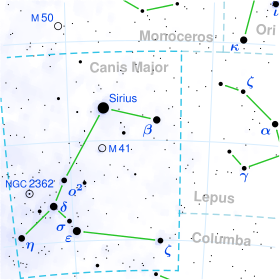
Back R Canis Majoris AST R Canis Majoris Catalan R Canis Majoris Spanish R Canis Majoris Italian R Большого Пса Russian R Canis Majoris Slovak R Canis Majoris Swedish 大犬座R Chinese
| Observation data Epoch J2000.0 Equinox | |
|---|---|
| Constellation | Canis Major |
| Right ascension | 07h 19m 28.18202s[1] |
| Declination | −16° 23′ 42.8773″[1] |
| Apparent magnitude (V) | 5.70 - 6.34[2] |
| Characteristics | |
| Spectral type | F0V + G8IV[3] |
| U−B color index | +0.01[3] |
| B−V color index | +0.34[3] |
| Variable type | Algol |
| Astrometry | |
| Radial velocity (Rv) | -39.0[4] km/s |
| Proper motion (μ) | RA: 165.37[1] mas/yr Dec.: −136.18[1] mas/yr |
| Parallax (π) | 23.38 ± 0.54 mas[1] |
| Distance | 44[3] pc |
| Absolute magnitude (MV) | +2.57[5] |
| Details[3] | |
| Mass | 1.67 + 0.22 + 0.8 M☉ |
| Radius | 1.78 + 1.22 + 0.83 R☉ |
| Luminosity | 8.2 + 0.49 + 0.4 L☉ |
| Surface gravity (log g) | 4.16 + 3.60 + 4.50 cgs |
| Temperature | 6,964[5] K |
| Rotational velocity (v sin i) | 78.3±3.9[5] km/s |
| Other designations | |
| Database references | |
| SIMBAD | data |
R Canis Majoris is an eclipsing interacting binary star system in the constellation Canis Major. It varies from magnitude 5.7 to 6.34.[6] The system is unusual in the low ratio between the main two components and shortness of the orbital period.[3]
- ^ a b c d e Van Leeuwen, F. (2007). "Validation of the new Hipparcos reduction". Astronomy and Astrophysics. 474 (2): 653–664. arXiv:0708.1752. Bibcode:2007A&A...474..653V. doi:10.1051/0004-6361:20078357. S2CID 18759600.
- ^ Samus, N. N.; Durlevich, O. V.; et al. (2009). "VizieR Online Data Catalog: General Catalogue of Variable Stars (Samus+ 2007-2013)". VizieR On-line Data Catalog: B/GCVS. Originally Published in: 2009yCat....102025S. 1. Bibcode:2009yCat....102025S.
- ^ a b c d e f Cite error: The named reference
buddingwas invoked but never defined (see the help page). - ^ Wilson, Ralph Elmer (1953). "General catalogue of stellar radial velocities". Washington. Bibcode:1953GCRV..C......0W.
- ^ a b c Ammler-von Eiff, Matthias; Reiners, Ansgar (June 2012), "New measurements of rotation and differential rotation in A-F stars: are there two populations of differentially rotating stars?", Astronomy & Astrophysics, 542: A116, arXiv:1204.2459, Bibcode:2012A&A...542A.116A, doi:10.1051/0004-6361/201118724, S2CID 53666672.
- ^ Watson, Christopher (4 January 2010). "R Canis Majoris". AAVSO Website. American Association of Variable Star Observers. Retrieved 18 February 2014.
